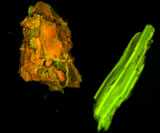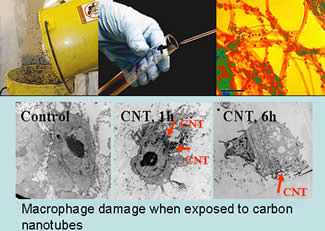Aerosol Research Overview
Aerosol Research
Since concentrated aerosols are sometimes found in the workplace and have been shown to result in a number of diseases, NIOSH has devoted a significant portion of their research to the study of aerosols.
This work initially focused on pressing issues such as black lung and silicosis, but has expanded to include many other areas, some of which are highlighted below.

Wildfires
NIOSH is conducting cutting edge research on the exposures of fire fighters to toxic aerosols while performing their duties.

Related NIOSH topic: Fighting Wildfires
Dust
Exposure of workers to high concentrations of “nuisance dust” can result in adverse health effects. Silica exposure is one of the key concerns, and NIOSH has done considerable research in this area.

Related NIOSH topic: Silica
Diesel Emissions
The exposure of workers to diesel particulate matter “ DPM”, especially critical for workers in underground mines, has become a major focus of recent NIOSH research.

Related NIOSH topic: Diesel Emissions and Measurement Control in Mining
Asbestos
The asbestos minerals often separate into very fine particles and are easily inhaled. Persons exposed to asbestos have developed several types of life threatening diseases, including lung cancer. NIOSH research has been part of the thrust to dramatically decrease the use of asbestos.

Related NIOSH topic: Asbestos
Toxicity Studies
At the extensive NIOSH research facilities, techniques such as confocal microscopy, transmission electron microscopy (TEM) and scanning electron microscopy (SEM), are used to investigate aerosol-induced damage to animal and human body tissues.

Metals
Due to their profound effects on body chemistry, metals are a key focus of NIOSH aerosol research. Research includes studies of particle formation mechanics as well as the toxicity potential of metal – bearing aerosols.

Metal-bearing Aerosols
Portable analytical methods for metal aerosol analysis are being evaluated by NIOSH. Here air sampling filters placed in holders are evaluated in the field by X-ray fluorescence. Accurate analysis is enhanced when the deposit is most even.

Coarse Aerosols
Since relatively large particles can irritate the upper airways, NIOSH researchers study the performance of samplers for coarse aerosols, such as wood dusts.


Respirators and Personal Protective Equipment
A cornerstone of NIOSH’s mission is to certify that respirators available to the public protect them from harmful airborne contaminants. Here a NIOSH employee tests a filter respirator with sodium chloride at the National Personal Protective Technology Laboratory in Pittsburgh.

International Work
NIOSH is active in addressing global health issues. In one recent study, extensive on-site measurements were conducted in India, to evaluate the aerosol concentrations of cooking-related fumes.


Nanotechnology
NIOSH is responding to the nanotechnology revolution by addressing the potential health impact of nanomaterials in the workplace. Current work includes evaluating material behavior and measurement / characterization techniques, and nanomaterial toxicity.

Related NIOSH topic: Nanotechnology
Download this NIOSH Research Overview in PDF form [PDF – 555 KB]
- Page last reviewed: July 20, 2010
- Page last updated: August 8, 2017
- Content source:
- National Institute for Occupational Safety and Health Education and Information Division


 ShareCompartir
ShareCompartir